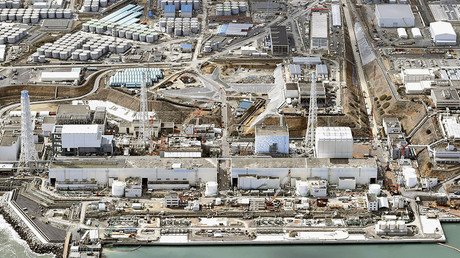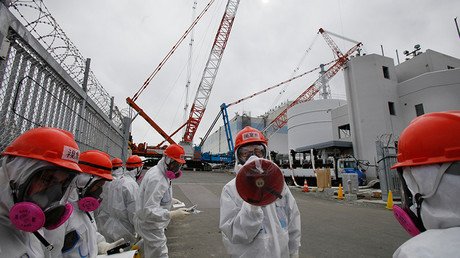‘Japan’s existence was at stake’: Fukushima disaster nearly prompted Tokyo evacuation – former PM

The fate of Japan hung on a “paper-thin margin” due to the government’s inadequate performance and the unprofessionalism of TEPCO’s executives after the Fukushima nuclear meltdown in 2011, which almost caused the evacuation of 50 million people.
Total chaos in operations and decision making reigned at the highest level in Tokyo, when the 2011 earthquake and tsunami forced the meltdown of three nuclear reactors at the Fukushima Daiichi nuclear power station, Naoto Kan, a former Japanese prime minister told The Daily Telegraph ahead of the fifth anniversary of the tragedy.
Making any decisions when TEPCO, the power station’s operator, offered “no clear information” to the scope of the disaster was nearly impossible.
“There was so little precise information coming in. It was very difficult to make clear judgments. I don’t consider myself a nuclear expert, but I did study physics at university,” Kan told the Telegraph.
With each hour the situation at Fukushima was getting worse. The massive 13 meter tall tsunami wave, triggered by a 9.0 magnitude quake, overwhelmed the plant's seawall, which was 10 meters high, cutting off power to the main control room which controlled the coolant systems of six separate boiling water reactors.
Kan admitted that when he received the news that the coolant at Fukushima had stopped working, it sent a “shiver” down his spine.
“I knew that even based on what little we were hearing, there was a real possibility this could be bigger than Chernobyl. That was a terrible disaster, but there was only one reactor there. There were six here.”
As workers struggled to supply power to the reactors’ coolant systems and restore power to their control rooms, a number of hydrogen-air chemical explosions occurred, allowing radiation to escape. The first explosion happened in Unit 1, on March 12, followed by a blast at Reactor 3 on March 14. The last explosion in Unit 4 happened on March 15.
The former PM said that from March 11-15 radioactive contamination was expanding geographically and if the meltdown trend was to continue and affect all six reactors, that would definitely have affected Tokyo.
At one point the situation reached a boiling point where the cabinet headed by Kan considered evacuating the capital Tokyo and surrounding areas in addition to declaring a martial law.
“The future existence of Japan as a whole was at stake,” he said. “Something on that scale, an evacuation of 50 million, it would have been like a losing a huge war.”
READ MORE: TEPCO admits announcing Fukushima nuclear plant meltdowns far too late
A total disaster that would have caused the meltdown of Fukushima’s all six reactors was averted when seawater was pumped into the units.
Kan who lost his post for the handling of the crisis was accused by parliamentary investigation of distracting emergency workers, withholding information, and his decision in ordering the “Fukushima 50” to stay at the plant. The Fukushima 50 are a group of employees that remained on-site after 750 other workers were evacuated.
“I went to the TEPCO offices and demanded they not evacuate. To this day I am criticized for that, but I believed then and I still believe now that I did the right thing and that that was a decisive moment in the crisis,” he told the Telegraph.
“We were only able to avert a 250-kilometre (160-mile) evacuation zone [around the plant] by a wafer-thin margin, thanks to the efforts of people who risked their lives,” Kan said. “Next time, we might not be so lucky.”
Throughout the entire ordeal, Kan said he was “very shocked” by the performance of Nobuaki Terasaka, director of the Nuclear and Industrial Safety Agency, who was later sacked. “We questioned him and he was unable to give clear responses,” he said.
“We asked him – do you know anything about nuclear issues? And he said, ‘no, I majored in economics.’”
Kan went on to accuse TEPCO of being responsible for the crisis, as “a lot of the accident was caused before March 11.” Management had known since June 2009 that the plant was vulnerable to a tsunami but had “failed to take pre-emptive measures [despite] knowing the risk.”
Five years after the disaster the Fukushima Daiichi nuclear power continues to pose a threat to the ecology and humans around it, Kan has admitted.
“In reactors 2 and 3, the radioactive fuel rods are still there and small amounts of [radioactive] water are leaking out of the reactor every day, despite what TEPCO says.”
Kan voiced regret that prime minister, Shinzo Abe, went on to restart some of the country’s nuclear power stations, saying that Japan had “not learned the lessons enough” and was “closing its eyes” to the risk of another disaster.
“Additional protective measures against tsunamis have been taken, such as raising the protective walls, but I don’t think they go far enough. We shouldn’t be building nuclear power plants in areas where there is a population to be affected. After the tsunami, Japan went without nuclear power for years, so it can be done,” the former PM said.
He admitted that the 2011 disaster has turned him into an opponent of nuclear power. “I have changed my views 180 degrees. You have to look at the balance between the risks and the benefits,” he said. “One reactor meltdown could destroy the whole plant and, however unlikely, that is too great a risk.”
At the same time, Kan voiced "regret" at not having made the readings from System for Prediction of Environmental Emergency Dose Information public. The accurately measured forecast of the radioactivity around the plant and could have saved thousands of local residents from exposure, he said.
While the Fukushima disaster caused no immediate casualties from radiation, the meltdown forced the evacuation of almost 400,000 people. An area within 12.5 miles of the plant remains an exclusion zone.














